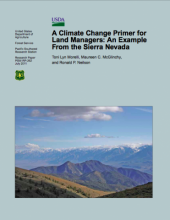A Climate Change Primer for Land Managers: An Example from the Sierra Nevada

Interest in location-specific climate projections is growing. To facilitate the communication
of these data, we provide here an example for how to present climate
information relevant at the scale of a national forest. We summarize some of the
latest data on climate change projections and impacts relevant to eastern California,
from the global scale to the state level, then focus on the Sierra Nevada, and finally
the Inyo National Forest. Most climate models project increased temperatures and
reduced snow cover across most of the Sierra Nevada, potentially causing water
shortages and cascading ecological impacts. For the Inyo National Forest, we
provide MC1 Dynamic General Vegetation Model outputs projecting a reduction in
the extent of alpine/subalpine ecosystems, an increase of woodlands and grasslands,
and an emergence of novel desert habitat in eastern Sierra Nevada by the end of the
21st century. Finally, we offer resources and possible alternatives to land managers
for climate change adaptation. Thus, our study provides climate change information
for a specific management unit in the West as well as an example for other regions.
We used this information as background for a climate-adaptation workshop held
in Bishop, California, in 2009. This workshop was part of a Westwide Climate
Initiative project to work with land managers to develop climate change adaptation options.
Morelli, T. L., M. C. McGlinchy, and R. P. Neilson. 2011. A climate change primer for land managers: an example from the Sierra Nevada. Pacific Southwest Research Station, United States Forest Service, Albany, CA. Retrieved from http://www.fs.fed.us/psw/publications/documents/psw_rp262/psw_rp262.pdf.
